14
"Mary F. Anderson" at River John, Nova Scotia, Canada1920
River John, Nova Scotia, Canada
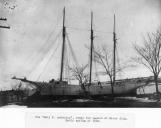 Credits:
Credits:North Shore Archives CSHC
15
When C.H.McLennan took over the Archibald MacKenzie shipyard in 1890, he had been associated with the industrty since he was 14, when in 1874, he worked in the steam kiln, tending the boiler. At the age of thirty he was managing a store and started operating the shipyard.Shipbuilding was well in decline by now but in 1899 he launched the "Sirdar", which carried cargos to Europe, South America, and the Caribbean, but she finally sank during a hurricane in the Gulf of Mexico in 1913. He built the last square-rigged barque in River John before he turned to schooners, which were more economical to operate.
In the stock market crash of 1910, C.H.McLennan lost everything, but with the onset of the 1914-1918 war, shipbuilding received a boost. McLennan sold a woodlot and with the proceeds and a part-owner, C.W. Anderson, built a ship named after Anderson's daughter, the "Mary F. Anderson". Freezing weather delayed the launch but she eventually carried lumber to France and was dismantled in 1936.
With the death of shipbuilding, McLennan pioneered the local lobster canning industry and was said to have about 12 factories based on River John from 1912 to 1929; these each employed about 15 people, and were supported by some 45 fishing vessels, owned by McLennan. He was concerned that the people left unemployed by the loss of work in the shipyards could at least get seasonal employment in the canneries.These eventually closed when a method of transporting lobsters live was introduced.
Charles McLennan died in 1930 and in 1972, his son offered the family home and shipyard as a historic site to the Nova Scotia government, but it was declined.
16
"Cyril T" Launch Preparations, River John, Nova Scotia, Canada1918
River John, Nova Scotia, Canada
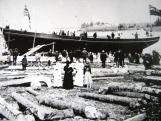 Credits:
Credits:North Shore Archives CSHC
17
The "Cyril T." was one of the last of the McLennan's yard ships. She was a three masted schooner that was sold to Newfoundland.Most of the timber used in the River John shipyards came from a ten to fifteen mile (16 km - 24.2 km) radius of the settlement. Later, spars were brought in from British Columbia and other Provinces.The lack of local timber helped in the decline of the industry, as it then had to be imported from elsewhere, by ship.
Since 1920, northwest gales have washed away large portions of land where the shipyards once stood. The result of the removal of sand and gravel from the bar that extended 3/4 of the way across the river (a natural breakwater), led to the erosion of the harbour waterfront, and silting of the entrance and channel.
There is no evidence now of the former lively industry.
18
"Rio de la Plata", built at River John, Nova Scotia, Canada1870
River John, Nova Scotia, Canada
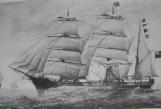 Credits:
Credits:North Shore Archives CSHC
19
Through the 1870s, the gradual decline of shipbuilding in the area was evident. The large stands of timber required for shipbuilding became scarce. Between the 1880s and 1890s there was a decrease in fish, coal, and timber trading; hence fewer ships were required. The population of River John dropped as people moved away looking for work elsewhere.After 1867, John A. Macdonald initiated a policy to encourage Canadian industry, and to have fewer imported goods. Improved roads, railways and steam vessels took over the market. The 'Age of Sail' was coming to an end.
20
Construction of "Cambrai", River John, Nova Scotia, Canada1917-18
River John, Nova Scotia, Canada
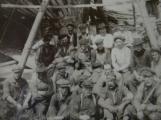 Credits:
Credits:North Shore Archives CSHC
21
In 1884, there was a big contest between the shipyards of Kitchin and MacKenzie/ McLennan. Each wanted to build the largest ship in Pictou County. MacKenzie/ McLennan produced "Caldera", weighing in at 1,575 tons. The "Caldera" made one voyage around the world. However, Kitchin came up victorious with the launch of "Warrior", of 1 687 tons with its extra hurricane deck. It was, in fact, the largest sailing ship ever built in the county. The hurricane deck was later removed as it was inconvienent.After 1861, Western Union Telegraph Service, an invaluable service for the operating of ships, was brought to the offices of two of the largest shipyards. It continued to operate from the Kitchin yard even after it became the River John Post Office (later taken over and run by the railway).
Long after the main shipbuilding times were over, a demand for vessels in wartime produced enough skilled labourers to produce a ship from the MacKenzie/McLennan shipyard for the 1914-1918 war effort She was called the "Cambrai.".
22
Schooner "Cambrai" at River John, Nova Scotia, CanadaEarly 1917?
River John, Nova Scotia, Canada
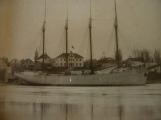 Credits:
Credits:North Shore Archives CSHC
23
TatamagoucheAdapted from the Church map of 1871, showing the major industrial and ship building sites of Tatamagouche. Although the sites are known, hardly any structures remain today.
Ships built varied in size from 7 tons (eg. 'Jane Ann' built by Thomas Langille) to 1000 tons (eg. 'Jumna' built by D and A Campbell). According to the size, they were used for coasting, foreign trade and fishing (usually in Newfoundland). Most were sold on the open market, but some were built under contract. Sometimes the builder retained interest in the ships he built, but many prefered to sell them outright. The foreman did the designing, although contract ships had specifications sent by the buyers.
It is surprising that there was little long lasting benefit to the community of Tatamagouche, although for 50 years the village was a hive of industry, with a lively night-life. The workmen in the shipbuilding yards and sailors gathered in the stores to socialise and drink rum that was readily available.
24
Shipbuilding in Tatamagouche, Nova Scotia, Canada1864 /74
Tatamagouche, Nova Scotia, Canada
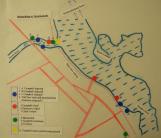 Credits:
Credits:North Shore Archives CSHC
A.F.Church Map
Roy Kennedy
25
Possibly the first known ship bult in the area was "Nelly" of 38 tons, built by Thomas Wellwood and Alexander Waugh.As the population and the demand for transport increased it was realised that the area was well placed to develop a shipbuilding industry. Situated where the Waugh's River and the French River joined and flowed into the Northumberland Strait, with a hinterland of vast forests of fine timber, and with numerous sheltered coves and bays along the shore, Tatamagouche was in an ideal position. However, Tatamagouche harbour was shallow and ships with over an 11 foot (3.3m) draft could not sail in beyond the sand bar some two miles (3.2km) out in the channel from the village.
There were young men eager to find employment other than working on the family farm. Skilled craftsmen were needed; carpenters, block makers, caulkers, riggers, blacksmiths all found work in the yards.
26
The "Mary Campbell",Tatamagouche, Nova Scotia, Canada1838
Tatamagouche, Nova Scotia, Canada
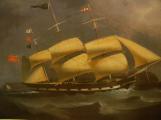 Credits:
Credits:North Shore Archives CSHC
27
Meanwhile, from 1800-1820, the lumber trade was developing. The Napoleonic Wars and their aftermath severed the timber supply from the Baltic and Great Britain needed timber. Ships were wanted to transport the timber, and with such ready markets, this greatly encouraged the shipbuilding industry in Nova Scotia.Before 1830, the first vessels were inexpensively and hurriedly built for the English market. They did not have a good reputation abroad! Sold outright, the builders did not receive a share for their work. This phase of the shipping business ceased after the war.